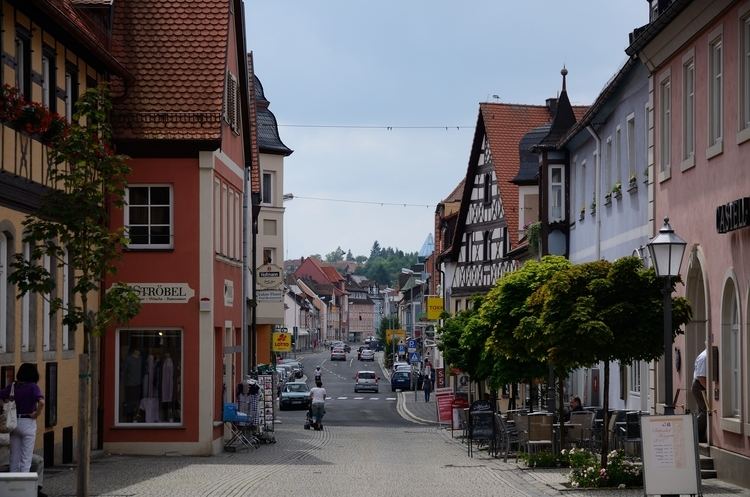Time zone CET/CEST (UTC+1/+2) Dialling codes 09161 Population 12,228 (31 Dec 2008) Postal code 91413 | Postal codes 91413 Area 61.2 km² Local time Saturday 12:40 AM Dialling code 09161 | |
 | ||
Weather 2°C, Wind NE at 6 km/h, 98% Humidity | ||
Neustadt an der Aisch (officially: Neustadt a.d.Aisch) is a small town of around 12,000 in the northern part of Bavaria (Germany), within the Franconian administrative region Middle Franconia. It is the district town of the district Neustadt (Aisch)-Bad Windsheim.
Contents
- Map of 91413 Neustadt an der Aisch Germany
- History
- Subdivisions
- Born in Neustadt
- Honorary Citizens
- People otherwise associated with Neustadt an der Aisch
- References
Map of 91413 Neustadt an der Aisch, Germany
History
In 741, for the first time, Riedfeld, the town's root settlement, was documented as the German king's court. However, in 1285 the town's name is documented for the first time as "Nivenstadt".
At the end of the 12th century, Neustadt became part of the sovereign territory of the burgraves of Nuremberg, the dynasty of the Hohenzollern. The House of Hohenzollern developed Neustadt into an economical, political and also cultural centre of its region, mainly because of its favourable geographical position in the middle of the main trade route between Würzburg and Nuremberg.
At the end of the 15th century, Margrave Albrecht Achilles and Kurfürstin (Electress) Anna completed Neustadt as a stronghold.
In 1553, in the Second Margrave War, the town was burnt down. Afterwards, a long lasting phase of construction and extension began. This phase ended with the destructions of the Thirty Years' War. The rebuilding after that war lasted several hundred of years.
From 1791 through to 1806, Neustadt was part of the sovereign territory of Prussia, then was military governed by the French, and in 1810 became finally part of the Kingdom of Bavaria. The political importance of Neustadt faded thereafter, but trade and industry kept growing due to the deployment of a garrison of the Uhlans, and in 1865 due to the opening of its station on the Nuremberg–Würzburg Railway.
In 1934, the town was the scene of an organized boycott against all Jewish merchants, and violence broke out against Christian Germans who patronized stores owned by Jews. Ultimately all of the Jews of Neustadt were expelled, many relocating to Nuremberg, and the Jewish synagogue was razed to the ground.
During the 20th century, traditional handicrafts (like brush-makers and makers of drawing instruments) almost completely vanished. With the resettlement of expellees from Sudetenland, new handicraft industries were imported: construction of musical instruments and the textile industry flourished.
From 1969 through to 1980, in total 16 Ortsteile were incorporated. In the course of an administrative reorganization (Gebietsreform), Neustadt became capital of the newly formed district "Neustadt (Aisch)-Bad Windsheim".
In the 1980s and 1990s, the infrastructure was improved on a grand scale: a beltway was built, and a pedestrian area around the market place was created; the cultural program was extended, and the old town was rehabilitated; new residential zones and business parks were established.
